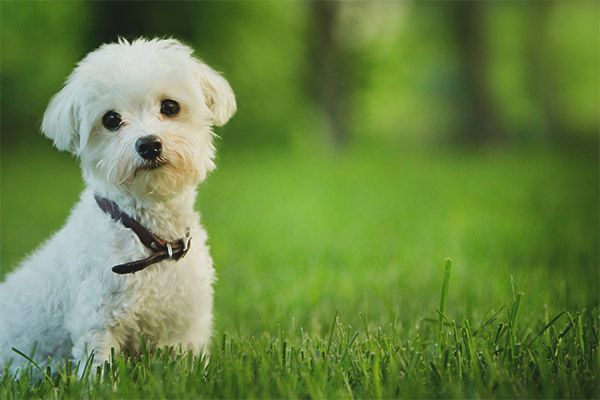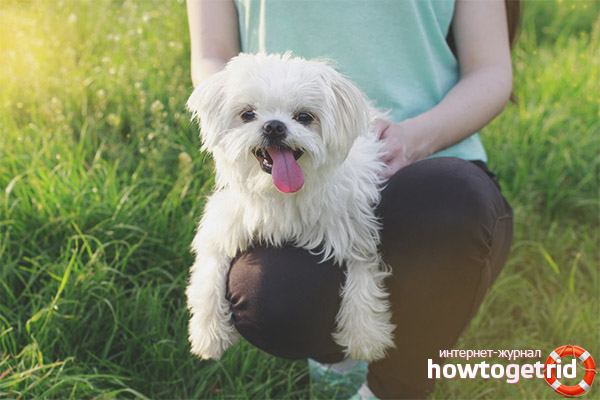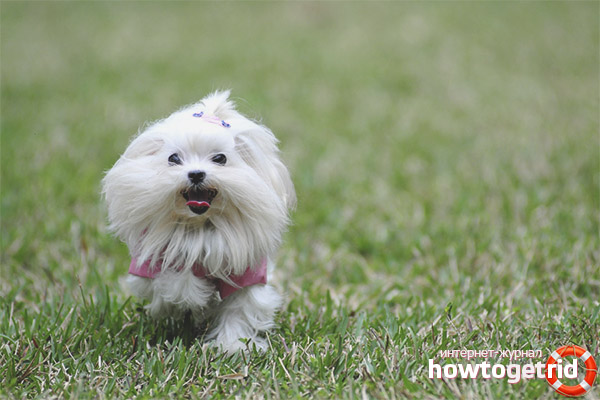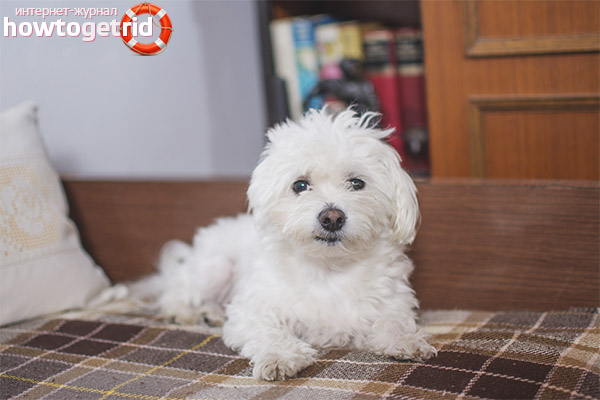The content of the article
For many years, unnatural popularity has remained for dogs of a miniature type; the Maltese is not included in the list of exceptions. Four-legged friends of this breed love for beauty, picky character, as well as a lot of other positive qualities. This is not only a great companion, but also a friend of the family. The historical summary includes many events, one way or another connected with the elegant breed Maltese. That is what they now call Bolonok, consider everything connected with them.
A bit of history
The external characteristics of the breed have no equal, many years ago, Maltese entrenched in various countries and every year their popularity only grows. Thanks to the breeders' activity, the breed was able to be maintained each time the risk of its disappearance appeared. But, fortunately, this has not happened for a long time.
From the family of lapdogs, the most ancient are the dogs called molossi. They are somewhat similar to the dogovs of our time. Some professionals have long contested this theory, while Charles Darwin did not pass his verdict.
By nature, a naturalist, having spent most of his life traveling, he describes the early ancestors of the Maltese lapdogs. Judging by the time frame, descriptions are peculiar to references up to the 6th century BC. That is, you can still argue, the Moloss were the forerunners of the lapdogs or vice versa.
If you do not listen to the verbal descriptions, which only are figures, molded from clay, in the form of dogs, which by breed look like lapdogs. They were discovered in ancient Egypt.
According to confirmed data, most of the Maltese breed settled on the island of Malta, in part this place played a decisive role in the formation of the name of pedigreed animals.
However, according to the second version, the name came from the island of Mljet, which is located in the Adriatic Sea (and Malta - in the Mediterranean). These two options are still considered valid, because disputes are fought at every opportunity.
From a historical summary, it is also interesting to mention that dogs of this breed roamed the world with such intensity that they soon won universal recognition.They carried the road very well, so they were often taken to ships and exchanged for precious silk. In those days, this kind of attributes was measured in gold.
Maltese has always been highly valued, in European countries they strictly controlled their numbers. If a wealthy family wanted a dog for themselves, she had to pay a tidy sum for purchasing a puppy. To this day, puppies are presented as a gift, they were previously a tribute.
The French were very fond of miniature dogs, so a large population was concentrated in this country. The dog could only be obtained from a narrow circle, because Maltese was widely demanded and valued.
Victoria, the Queen of Great Britain, wanted to have a lap-dog, as a result of which they were brought straight from the Philippine Islands. But during transportation, the kids, so to speak, lost their appearance and did not look presentable. The ruler did not receive the dogs, they were sent to the nursery to the mastiff breeder.
This event gave rise to the beginning of tribal activity in England. Each time the lapdogs became more and more, soon they were already divided into several world standards.The first is the American lap dog, the second is the classic Italian one.
External breed characteristics
If you start from the standards stated by the Kennel Union of America, the dog’s weight should not exceed 2.7 kg. At the same time, the International Canine Federation (ICF) puts a weight limit of around 3-4 kg. It all depends on the classification of the dog and the country of origin. If the exhibition pet, you need to focus on the IFF. Particular attention is paid to the size of the animal, bitches reach 23 cm, males are larger, from 22 to 25 cm.
- Head. Despite the pet's miniature size, the head is quite large. It can reach 1/3 of the size from floor to withers. At the expense of the wide skull, the lapdog looks cute, with a haircut something like a toy. The back of the nose is at right angles to the head. Muzzle square or rectangular shape. Lips are neat, cheeks are not visible, cheekbones too.
- Teeth. In individuals that meet the standard, the correct bite. Neither the upper nor the lower jaw protrudes forward. Teeth average power, but strong.There are no gaps between the canines.
- Nose. Small, black, the correct form. Pigment spots are not allowed, a different color (except black) is also a deviation. Nostrils are round, small.
- Ears. Triangular, hanging, slightly standing at the base. At the ends are rounded, but after cutting the wool creates a square appearance. The ears are pressed against the skull. When a dog is interested or excited playfully, they are slightly elevated and sticking forward.
- Eyes. Not sunk, not protruding, similar to the buttons in dog-toys. Distinctly shine, in dark shade. The eyelids are also black. If you look into the eyes of a pet, proteins are not visible. Round eye slit. Almond-shaped or mown is considered a defect. The richer the shade, the better the individual.
- Housing The body of an elongated shape is one third longer in length than the height of the dog from floor to withers. Due to the long hair is not visible relief. The skin is perfectly toned, does not sag, according to the standard, there may be some pigmentation in the form of small spots. On the body to the neck there is no apparent bend. The withers are clearly not visible, the back is straight, there is a slight slope in the area of the rounded croup.He slightly goes down to the thighs, so that the back part looks squat. Thorax developed, but not massive.
- Tail. Thin, not too long, tapers towards the end, almost like other similar breeds. The length is about ½ of the height from the floor to withers. The dog wears a tail high, especially when it is playful or interested. The tail is bent in some semiring, as a result of which it touches the croup.
- Limbs. Muscle tissue is moderate, it can not be called highly developed. The musculature is strong, the joints and bones are hardy, plastic, so when you move the dog looks free, but not constrained. If viewed from the side, the limbs are posterior to the front, straight, without folds. The elbows are directed backwards, not inward towards one another. Pads on the paws only black, other colors are unacceptable.
Training and breed character
- If you properly raise a puppy, he will grow up with a loving caress, which will treat all its host with all respect. It should not be forgotten that the Maltese are the best companions. Not for nothing in the historical paintings they are depicted next to the women rulers.
- By mistake, many owners do not pay enough attention to the Maltese training.Dogs cannot survive on their own, because they have a constant presence in nature close to the owner. The first thing that needs to be learned and consolidated is the “To me!” Command. Especially if you let go of the pet without a leash.
- The main positive feature of lapdogs is that they are able to concentrate and understand the person well. Therefore, pet training begins at an early age. They are prepared for the exhibition or taught tricks for common development as a pet of the family.
- By its nature, the lap dog is extremely energetic, it needs to communicate with a person and regular physical shakes. Nothing wrong with that you take a dog for a run or let go to run in the park. The main thing is that the dog should know the commands so that later it does not have to catch it throughout the district.
- Maltese always chooses one owner, who will be the "leader of the pack", the authority, the head. Therefore, do not try to make the pet listen and respect all family members at the same time. If the dog chooses you, you can be sure of its loyalty.
- If a cat lives in the same housing as the Maltese, they will most likely become friends.The main thing is not to give preference to anyone so that both pets of the family feel comfortable. As for children, lapdog gets along well with them, but with strong attacks it can snap.
- We can not say that lap-dog - a true guard. But if an outsider appears on the horizon that causes a threat, it will show itself aggressively and may well bite. It is necessary to know the owners, who often have many people in the house (friends, colleagues, etc.).
- Another positive trait of the breed - the lapdog quickly gets used to walking on a tray, like all little dogs. You easily accustom darling to diaper. But it should be understood that this does not negate walks in the fresh air. Otherwise, the dog for the release of energy can spoil things and furniture.
Color and type of wool
- If you look at the photos of the breed presented, you can conclude that the dog looks more like a toy or a statuette. This impression is due to the long, smooth and silky hair.
- With proper care, the wool will not break up into strands and curl. If you stroke the dog, you can feel that the coat is quite dense, heavy and silky. Even the pet's hair falls on the body of the animal.Bale area and beard harmoniously dissolved in the total mass of the coat.
- Many breeders prefer a pure white or cold color. Among the standards allowed shade of ivory or beige. But if you see a dog with that coat color alive, you might get the impression that it is dirty. Therefore, this shade is not welcome.
- Separately, it is worth noting that the breed in question can be excellent pets even for a person with allergies. The main feature of dogs is that they have no undercoat. Wool itself does not provoke allergies, with the exception of skin discharge from an animal.
- If you have an allergic reaction, it is recommended that you contact the pet several times before acquiring a pet. If you have not revealed a negative reaction, you can safely take a puppy. If you have any questions, feel free to ask them to the breeder.
Care and maintenance
- Maltese lapdog requires special care. Only in this case, you can achieve a really beautiful animal. In a sense, you have to make sacrifices. Such dogs should be kept exclusively at home.Also, with a pet regularly need to walk and give physical exertion.
- Under the procedure of care should be highlighted some rules. It is mandatory for a dog to comb wool every day with a wooden comb. Try to teach your puppy to be combed from the first days. The molt will occur gradually, as the dog has no undercoat. Spend about 25 minutes and there will be no problems.
- It is recommended to bathe the animal only when it is contaminated. It is a mistake to believe that a dog with a white coat needs to be bathed daily or 2 times a week, this is far from the case; fanaticism is not necessary. Due to such frequent manipulations, on the contrary, the wool will quickly become dirty. Pet skin problems may also occur.
- As an excellent alternative to permanent care, it is recommended to regularly seasonal haircut. In the hot season, the pet is recommended to cut it shorter. Accordingly, in winter, wool should be long. If the dog is preparing for the show, the haircut should be forgotten.
- It is strongly recommended to inspect the eyes every day and wipe them if necessary. Unfortunately, the presented breed has a tendency to diseases of the eye.Therefore, a thorough examination and the slightest suspicion of anything can save animal vision. Do not even think of taking independent measures, consult your veterinarian. Procrastination may sadly appeal.
- It is recommended to brush your ears once a fortnight. In parallel, you can cut the claws. If you have purchased shoes for your beloved pet, the care of your claws should be more focused. Also, special attention should be paid to the teeth. Give hygienic treats in time, which prevent the formation of tartar.
- Fortunately, all Maltese dogs have excellent teeth and an almost Hollywood smile. But this does not mean that they do not need to care for. All miniature dog breeds are prone to the loss of milk teeth. If you miss such a moment, the canines or incisors can grow crooked. As a result, bite deteriorates, or inflammatory processes develop.
- To preserve the original appearance of the pet and not to dirty his wool during walks in the winter, you should stock up with several sets of overalls. You can also buy shoes. Clothing should be worn exclusively. Otherwise, the formation of koltunov is inevitable.
- It is especially important to note one feature of the breed. Dogs are prone to frequent dermatitis. In order to prevent the development of this pathology, it is necessary to carry out prevention regularly. Mandatory processing of fleas and ticks. The procedure should be done every 4 months.
- Strictly follow the instructions that come with the drug. There are universal flea drops. They protect against such insects for 3 months, and against ticks for only 1 month. Therefore, if you notice that the animal often itches, immediately visit the veterinary clinic.
- The reasons may be mass. Also, do not exclude the most banal in the form of an allergic reaction. In other cases, a specialist to establish the cause will take scraping. It is important to know that Maltese has very delicate and sensitive skin. Because of this, they often form dermatitis quickly. In extreme cases, the veterinarian will prescribe a comprehensive treatment.
If you decide to purchase such a wonderful puppy, you should be prepared for the scrupulous care of the animal. The rest of the dog is not picky and very friendly.Furry pet will become a favorite member of the family, which simply can not fall in love. It is highly recommended to have regular haircuts if you are not going to take the animal to the show. As for food, then everything can be purely individual. Therefore, this question is better to check with the breeders.
Video: Maltese dog breed














To send